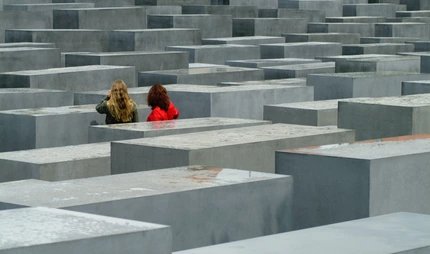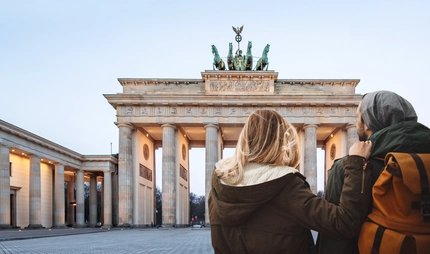
Ministergärten
Where Germany’s federal states are represented
What was once the site of Hitler’s Reich Chancellery is now the location of the offices of Germany’s federal states.
The green space nearest the centre of Berlin is a large landscape garden. The 4000 square metre site is deeply entwined with politics and history. It is where Germany’s federal states – the Bundesländer – have their offices to maintain their influence on national politics.
The grounds of the Ministergärten
The present site – on the corner of Ebertstraße and In den Ministergärten – was designed by the landscape architects Bernard and Sattler in 2007. Fifteen poplar trees are spread among seats and green embankments, some of which are planted with vines. Two entrances lead to the grounds. Three quarters of the 4000 square metre area can be hired for events such as presentations or parties. Walking through the grounds, there is always something new to discover. On one day it might be an open-air exhibition, on another the latest generation of cars, and every autumn the Jazz in den Ministergärten festival.
From the palace gardens to the bunker complex
The area near the Brandenburg Gate first got its name in 1732 when Friedrich Wilhelm I was king of Prussia. Wilhelmstraße was where Prussia’s most important ministries were located. These later came to include the Ministry of Justice, the Ministry of State and the offices of Otto von Bismarck. In the 18th century, the ministers lived in the elegant palaces on Wilhelmstraße, which all had large gardens to relax in.
After the fall of the monarchy, during the Weimar Republic, the area remained the seat of the great state institutions. When the Nazis took power, they added the new Reich Chancellery to the old National Gallery on Vossstraße. In the garden of the Reich Chancellery, from 1940 onwards, a bunker complex was built, to which various facilities were added. This was where the Third Reich met its downfall ion the final days of the war. Hitler committed suicide and the Red Army took Berlin. In 1947, the Soviets attempted to blow up the bunker, and further demolition work started in 1959.
When the Berlin Wall was built, the bunker site and the Ministergärten were border territory. In 1973, parts of the complex were opened once again and documented. Along Wilhelmstraße (which was known at the time as Otto-Grotewohl-Straße), the reinforced steel roof of the bunker was removed and the cavity filled in so that blocks of flats could be built.

Landesvertretung Niedersachsen
The offices of the Bundesländer are characterised by their individuality
After reunification, Berlin once again became the capital of Germany. Because all its federal states naturally wanted to be close to the centre of political power, 16 representative offices were built in Berlin to act as shop windows for the Bundesländer.
Between 1995 and 2001, representative offices for seven of them – Rhineland-Palatinate, Lower Saxony, Schleswig-Holstein, Brandenburg, Mecklenburg-Vorpommern, Saarland and Hesse – were built in a park complex on the corner of Ebertstraße and In den Ministergärten. Brandenburg and Mecklenburg-Vorpommern shared a building, as did Schleswig-Holstein with Lower Saxony. Each building was designed by a different architect’s office, which means every Bundesland has a very individual representation.
Because part of the Ministergärten was chosen for the site of the Holocaust Memorial, not all the Bundesländer were able to build offices here. The representations of Baden-Württemberg, Bremen and North Rhine-Westphalia are in the Tiergarten quarter, Hamburg is on Jägerstraße, Bavaria is on Behrenstraße, Thüringen on Anton-Wilhelm-Amo-Straße, Saxony on Brüderstraße and Saxony-Anhalt on Luisenstraße.



